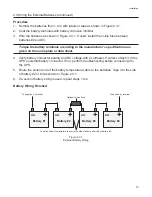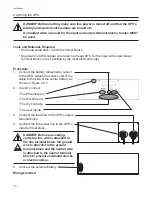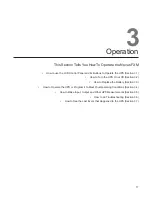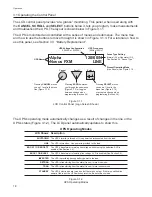
3
Introduction
1.1.2 Battery Safety Checklist
Battery Emergency Procedures
If electrolyte splashes on your skin, immediately wash the affected area with
water. If electrolyte gets into your eyes, wash them for at least 10 minutes with
clean running water or a special neutralizing eye wash solution. Seek medical
attention at once.
Neutralize spilled electrolyte with special neutralizing solutions in a “spill kit”
or a solution of 1 lb. (0.45 kg) of baking soda (bicarbonate of soda) in 1 gallon
(3.9 L) of water.
Battery installation and servicing should be done or supervised by personnel
knowledgeable about batteries and their safety procedures.
Never
open or damage the batteries. The electrolyte is harmful to the skin and eyes and
may be toxic as well as being an environmental hazard.
Never
let live battery wires touch the UPS, the enclosure or any other metal objects. This
can cause a fire or explosion.
Never
put metal tools on top of the batteries or on their
connectors.
Lead-acid batteries can release Hydrogen gas.
Never
expose the UPS or enclosure to
open flames or sparks to prevent a fire or explosion.
Inspect the batteries once a year for signs of cracks, leaks or swells. Replace as needed.
If you have batteries in storage, charge them at least once every three months for optimum
performance and to extend their lifetime.
Always
replace batteries with ones of identical number, type and rating.
Never
install
old or untested batteries. One sealed lead-acid battery is rated to a maximum voltage of
12VDC.
Before connecting the batteries to the UPS, determine if they are accidentally grounded
and unground the batteries if they are.
Always
use insulated tools to prevent accidental shocks. Wear rubber gloves and boots.
Remove all rings, watches, jewellery or other metal items before working inside the
enclosure or doing maintenance on the UPS to prevent accidental shocks.
Follow the manufacturer’s instructions for battery disposal. Recycling is the best method.
Never
burn batteries to dispose of them. They may explode. Follow the manufacturer’s
directions for safe battery disposal.
. Safety Checklists (Continued)
Summary of Contents for 500
Page 2: ...Power Alpha Technologies ...








































